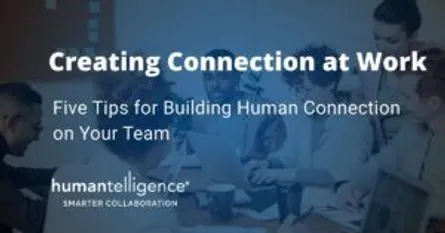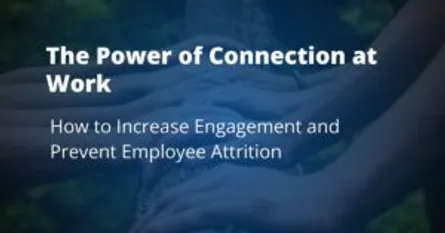
Connection

5 Tips for Building Human Connection on Your Team
- 13 Sep, 2023
- Collaboration
We spend half our waking weekday hours working. So it's no surprise that so many of us place a high value on our work friendships and close working relationships with colleagues. And if you think about it, those relationships exist because the conditions were just right for creating connection at work. A warm team environment can make or break the employee experience. But with the rise of remote work and flexible scheduling, it’s harder than ever to form those tight-knit bonds with co-workers. In fact, according to Gallup, 9 in 10 remote-capable employees prefer remote flexibility, and 6 in 10 prefer hybrid work. Of those preferring hybrid work, one of the top reasons for it was a desire to feel more connected to team members and to the organization. And there are major benefits to enabling connection among team members. So in our more remote, work-from-anywhere world, establishing human connection isn’t impossible. It just takes some more effort and focus. Employers increasingly need to play an active role in fostering these connections and ensuring employees feel engaged and motivated at work. But why? Creating Connection at Work Improves Employee Retention What secured your new hire is not going to keep them. Employers are attracting employees through flexible work, competitive salary and benefits, and claims of work-life balance. Employees will choose to stay when they feel connected to their peers, manager, organization, and work. Employee retention about getting the basics right. Building connection means ensuring new employees feel a tie to their work. They understand how they are contributing meaningfully to the mission of the organization, and have a sense of belonging. People must feel these connections immediately. In the virtual workplace, employers must work even harder to make and keep connections. Often this means entirely revamping onboarding for greater effectiveness. Below are some tips to help you start creating connection at work for your employees. Tip 1: Start connecting with employees at recruitment & onboarding First, show candidates how your organization is one that is worth their investment even before they accept a new job. In a world where many HR processes are automated, organizations that take a personalized approach to hiring will make a strong impression. For example, automating tax form completion is efficient, but having a personal conversation about an employee’s start date elevates the experience of connection. Handwritten notes, phone calls to check in, and introductions to fellow employees are ways to draw employees in before they get started -- and plant seeds for creating connection. Figure out how your new hires learn and communicate best, and then tailor the onboarding and training to those tendencies. It’s easy to figure that out when you use a psychometric assessment that shows an employee's common behaviors, motivators, values, and work energizers. This is the kind of information that you often only get after months or even years of working with someone, but with just a quick 12-minute personality survey, you can get at this info quickly – and start leveraging it to build connection during onboarding. Your new-hire will feel the difference! Tip 2: Make appreciation a part of work An act of appreciation or recognition is a key factor in feeling connected. When someone takes the time to acknowledge or appreciate your efforts, it has a powerful effect. It says “I see you.” An employee recognition program can be formal or as simple as increasing and normalizing appreciation. In fact, when employees are thanked 12 times, attrition falls to just 2%. Workers recognized in the last month are half as likely to be looking for a new job (26% vs 49%). And you can even institute compelling recognition programs even if you have a small team or limited budget. No matter where you land on this spectrum, here are some ideas to get started. Spotlighting strong performance can transform a content employee into a fully engaged one who actively pushes for greater things. Drives Excellence – Employee recognition is the foundation for creating a high-performing team. It strengthens relationships and provides a clear purpose aligned to achievable goals. Recognizing performance allows business leaders to drive toward key goals like retention by connecting people and culture to shared purpose. Increases Engagement – Eighty-four percent of those surveyed in this SHRM/Workhuman Employee Recognition Survey said that social recognition measurably and positively impacted engagement. Reinforces Company Values – Because employee recognition should be designed with rewards that map back specifically to each value, it integrates those ideals into employees’ everyday thoughts and actions. Nurtures Trust – According to a 2017 study, nearly 90% of employees who received recognition from their boss indicated high levels of trust in that relationship vs. just 48% for those who received no recognition. Research shows that workers who trust senior leaders are nearly 2x as likely to be engaged. Impacts Bottom Line - Organizations with formal recognition programs have 31% less voluntary turnover than organizations that don't have any program at all.Start simple…add an agenda item to your meeting to go around the group and let people “shout out” appreciation to anyone who’s helped them or done something noteworthy since the last meeting. It’s simple but powerful, and helps people bond. Tip 3: Make meetings more personal and less transactional to create connection at work We all still spend a lot of time in meetings, and while they can feel like a necessary evil at work, they can be an incredible opportunity to build overlap with others when approached with that intention. The key is to invite people to share more about themselves in the meeting. One effective way teams do this is by adding a “question of the day” to the agenda. The question might be something as simple as “where did you grow up?” to something more fun like “what’s your favorite movie of all time and why?” The goal is simply to invite people to share more about themselves in a safe, nonthreatening way. The magic of doing this is in the potential for a spark of connection. When two people realize that they grew up in the same place or share a common interest, they take a step or two away from just being co-workers in the direction of becoming friends. Tip 4: Creating connection at work through communities of practice A community of practice (CoP) is a group of people who share a common concern, a set of problems, or an interest in a topic and who come together to fulfill both individual and group goals. Communities of practice exist to take advantage of the expertise within the company. They give employees and teams opportunities to share their knowledge, brainstorm, and collaborate across multiple locations – of which builds connections among employees who might not otherwise have to interact. Employees involved in communities of practice have opportunities to develop their current areas of expertise and grow their knowledge by solving problems with their colleagues. They also gain the advantage of feedback and support from experts. Documents related to the communities of practice are stored in a library accessible to employees. The work performed by these key players benefits others later. Tip 5: Use integrations within your existing communication tools For any work arrangement, whether in-office, hybrid, or remote, keeping your employees connected through technology is a must. Beyond using email, Slack, Teams, Zoom, or other collaboration software, consider squeezing more from your investment in those tools by integrating a quick add-on that gives each team member the insights needed to establish stronger relationships with another – all before they even start communicating. When drafting an email, chatting with a colleague, or joining a meeting, this add-on automatically surfaces useful, customized tips for more effective communication that ends up helping you improve your relationships at work. Consider the use case of one-on-one check-ins. One of the most powerful and simple steps a manager can take to help an employee feel more connected and productive is to check in with the employee regularly. Learning how to check-in effectively means inviting the conversations that really matter with the employee and providing the support and encouragement they need. Now, add in a layer of knowing how best to approach that employee based on their communication, collaboration, and work styles, and your one-on-ones will be more productive than ever – and your employee will feel more seen and connected than ever. It's a way to start creating connection at work before you even meet, and it’s a total game changer for managers.

The Power of Connection at Work
- 30 Aug, 2023
- Collaboration
The way we work has changed. Distributed teams along with generational differences and diverse personalities make collaboration, communication, and connection at work more difficult than ever. Miscommunications that could be easily rectified with a quick face-to-face chat now are left to fester at our keyboards. At the same time, the world of flexible remote and hybrid work has opened up many opportunities for employees around the world. Unfortunately, some of those opportunities lead to other companies. That doesn’t mean remote work isn’t working. It just means we need to do a better job of encouraging interpersonal connection at work. In this article, see how you can harness the awesome power of human connection to improve employee engagement and increase retention. The High Cost of Losing Connection at Work The sudden shift to remote work over the past couple of years gave our people an opportunity to do more than just spruce up their home offices – it also gave them a chance to think and reevaluate bigger topics, like just how work fits into their lives. And this has undoubtedly contributed to trends like the Great Resignation and quiet quitting, as many employees realized that personal needs, such as connection, family, happiness, and health mattered more to them than promotions, career paths, and other work-related objectives. In fact, according to Gallup, U.S. employee engagement took a giant step backward during the second quarter of 2022, with the proportion of engaged workers remaining at 32 percent while the proportion of actively disengaged increasing to 18 percent. This put the ratio of engaged to actively disengaged employees at 1.8 to 1, the lowest in almost a decade. We don’t have to tell you, this turnover can leave your organization in a bind. Estimates show that every time a business replaces a salaried employee, it costs 6 to 9 months’ salary on average. For a manager making $60,000 a year, that's $30,000 to $45,000 in recruiting and training expenses. This doesn’t even account for all of the soft costs required to onboard a new employee, the impacts on morale and culture, loss of knowledge and productivity, or the ways that whole teams can be affected when it’s a team leader who leaves. Not to scare you further, but research out of LinkedIn also shows that 70 percent of the global workforce is passive talent, and more than half would consider leaving for the right opportunity. So basically, everyone is a flight risk! The good news is that one of the most important and impactful solutions takes into account the fact that work life and personal contentment aren’t mutually exclusive. In fact, everything – including employee engagement and retention – improves when we bring the two into alignment through deeper connection. The Importance of Connection at Work Connection at work matters. Would you be surprised to learn that people with friendly connections at work perform better in their job? According to research, people who have a good friend at work are not only more likely to be happier and healthier, but they are also seven times as likely to be engaged in their job. In addition, employees who report having friends at work have higher levels of productivity, retention and job satisfaction than those who don’t. The feelings of belonging and purpose that friendship and connection foster are among the top benefits people are looking to get from their work. These feelings are so profound and powerful that some employees would even trade some compensation for more meaningful relationships – at least that’s what over half of the employees surveyed by BetterUp Labs found. Feeling more connected at work doesn’t only make employees happier. It has several other clear effects on employee and organizational performance. For example, 94 percent of employees agreed that they’re more productive when they feel connected to their colleagues, and, when compared to employees who didn’t feel actively connected to their workplace, connected employees were:More than 3 in 5 employees with high social connectivity report being highly engaged, whereas just over 1 in 10 employees with low social connectivity consider themselves highly engaged at work. Employees who have strong social bonds with their coworkers are more motivated to perform. Individuals who report having connection at work are 7x more likely to exhibit better engagement, customer relations, work quality, and wellbeing, as well as a lower risk of injury. Highly engaged teams show 21% greater profitability.Employee engagement consists of concrete behavior, not an abstract feeling. Organizations that view engagement as a feeling often conduct employee surveys and provide offer perks to improve the results. Gallup reports that the most successful organizations make employee engagement central to their business strategy. They give employees clear expectations and provide them with the tools and support to do their best work. Why are engaged teams more profitable? Those teams who score in the top 20 percent in engagement realize a 41 percent reduction in absenteeism, and 59 percent less turnover. Engaged employees show up with passion, purpose, presence, and energy. So, let’s turn our focus toward increasing connection – and that doesn’t mean forcing everyone back into the office. Return-to-Office Doesn’t Always Make for Better Connection A recent study from Accenture found that on-site workers were the most likely to say they felt disconnected at work. The study challenges the assumption that working only on-site makes people feel more connected. People who work on-site, in comparison with those who work in hybrid or remote workplaces, feel the least connected of the three groups studied — 42 percent of on-site workers say they feel “not connected” versus 36 percent hybrid and 22 percent fully remote. While in-person time is vital, physical proximity that lacks leadership support, flexibility, technology or sense of purpose doesn’t necessarily translate into people feeling deeper connections to their work and to each other. It’s not about the building, the site, the campus. As with most things in this life, it’s about what’s going on inside that counts. Accenture’s Organizational culture: From always connected to omni-connected report outlines how companies can strengthen culture and connection by delivering what they refer to as “omni-connected experiences,” which level the playing field, enabling people to participate fully and have an equitable experience — growing their careers, building relationships, and creating both personal and business value and impact — regardless of where they physically work. In Enboarder’s research of building connection at work, survey findings showed that the things that made the biggest impact on employees' feelings of connectedness, and hence, their retention rates were things you’re probably already doing: team meetings (49%), skills sharing with coworkers and peers (29%), spontaneous interactions with colleagues (28%), and all-company meetings (26%). Now What? Just because you're already doing it doesn’t mean it’s working well. Consider optimizing these efforts and employing technology that supports them. The key to deeper connection and strong engagement is to simply enable and activate the everyday interactions between coworkers. Make sure your employees are making the most of their in-office days and that there are adequate spaces and reasons for in-person interactions. Encourage spontaneous check-ins. With fewer people around us, it’s easy just to immerse ourselves in work, but regular check-ins with others are crucial for everyone, in particular leaders who may not otherwise notice if their team is struggling. Make sure your remote employees aren’t being overlooked for team and company events. Be mindful to create opportunities for genuine human connection. Support informal mentorships. Facilitate communication across departments and employees of different ages and experience levels so team members can learn more about each other and their areas of work, while sparking new ideas and interests.If anything good came out of our rapid, pandemic-induced shift to remote work, it was that we finally had the unique opportunity to meet many of our colleagues’ families and pets over Zoom. This helped us see them as the human beings they are, which fueled a sense of connection when we needed it most. Now, we have the opportunity to take that sense of connection and amplify it. Remember, increasing employee retention doesn’t just help your company; it helps your people. An employee who feels connection at work, is an employee who can engage fully. And an employee who can fully engage is an employee who feels compelled to stay. Need help getting your employees connected and on the same page, talk to one of our solutions experts!